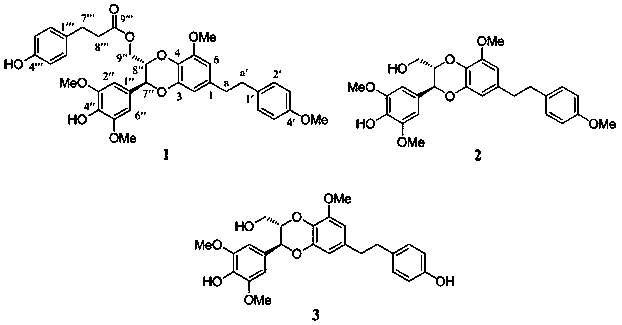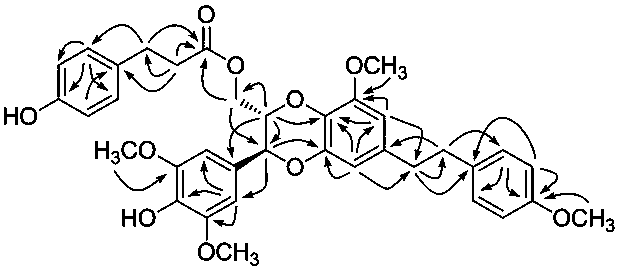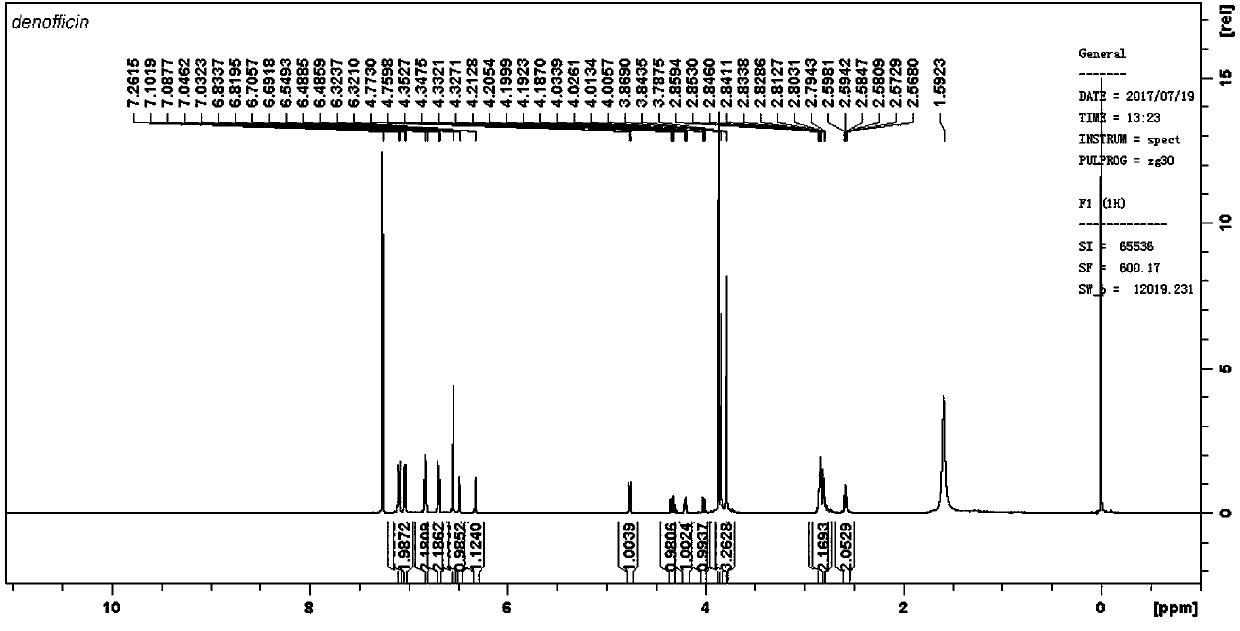A bibenzyl derivative in dendrobium officinale leaves and its preparation method and application
A bibenzyl and compound technology, applied in the field of medicine, can solve problems such as waste of biological resources, and achieve the effects of extending the value chain, novel structure, and significant respiratory burst activity of PMNs
- Summary
- Abstract
- Description
- Claims
- Application Information
AI Technical Summary
Problems solved by technology
Method used
Image
Examples
Embodiment 1
[0029] Example 1 Preparation of bibenzyl compound denofficin in Dendrobium officinale leaves
[0030] Take 30 kg of shade-dried Dendrobium officinale leaves, crush them, and extract them twice with 150 L of 95% ethanol at room temperature for 20 days each time, filter the extract, recover the solvent under reduced pressure, and obtain 1.7 kg of black extract. Take 1.5 kg of extract, disperse it with 3 L of 10% ethanol hot solution, put it on HP-20 macroporous adsorption resin column (50 × 15 cm), and then wash it with water, 10% ethanol, 20% ethanol, 30% ethanol, 40% ethanol , 50% ethanol, 60% ethanol, 70% ethanol, 80% ethanol, and 90% ethanol for gradient elution, and each gradient eluted with 5 column volumes to obtain 10 fractions frs. H0-H9.
[0031] Fraction fr. H7 (76.2 g) eluted with 70% ethanol was chromatographed on MCI CHP-20P resin column and eluted with ethanol-water solvent system (20:80~90:10) gradient to obtain 8 fractions frs. H7M1 -H7M8. The fraction fr. H7M...
Embodiment 2
[0033] Example 2 Structural identification of 3 bibenzyl compounds isolated from Dendrobium officinale leaves
[0034] Compound 1 is a white amorphous powder. HR-ESI-MS gives quasi-molecular ion peaks m / z 629.2388 ([M-H] - , Calculated value: 629.2392), determine its molecular formula as C 36 h 38 o 10 . The IR spectrum of Denofficin shows the hydroxyl group (3519, 3445 cm -1 ), methoxy (2936, 2852 cm -1 ), carbonyl (1733 cm -1 ) and aromatic rings (1606, 1516,1454 cm -1 ) characteristic absorption. That 1H NMR spectrum (600 MHz, CDCl 3 ) shows 12 proton signals from four aromatic ring systems. Among them, 8 are from two independent A 2 B 2 Type aromatic ring spin coupling system signal: δ H 7.10 (2 H, d, J = 8.5 Hz, H-2′, 6′), 6.83 (2 H, d, J = 8.5 Hz, 3′, 5′), 7.04(2 H, d, J = 8.3 Hz, H-2′′′, 6′′′), 6.70 (2 H, d, J = 8.3 Hz, 3′′′, 5′′′); 2 signals from a set of 1,3,4,5-symmetric tetrasubstituted aromatic ring protons: δ H 6.55 (2 H, s, H-2′′, 6′′)...
Embodiment 3
[0039] Example 3 The cytotoxicity evaluation experiment of the three bibenzyl compounds isolated on rat PMNs
[0040] Rat PMNs were isolated and purified using the following experimental procedures. Take clean-grade SD rats (Jiangxi University of Traditional Chinese Medicine Experimental Animal Center, animal license number: SCXK (Gan) 2018-0003), take 9 mL of blood from the orbit, drop vertically into the glass that has been anticoagulated with 1 mL of 1% heparin sodium in a centrifuge tube. Add 4.5% dextran T-500 saline solution at a ratio of 5:1, mix well, and let stand at 4°C for about 1 hour. Take the supernatant, add it to the centrifuge tube pre-filled with lymphocyte separation medium at a ratio of 3:1, 800 rpm (275 g ) Centrifuge for 15 minutes, take out the centrifuge tube, the tube is divided into three layers, the upper layer is light yellow serum, the middle white misty area is monocytes and lymphocytes, and the lower layer is PMNs that settle to the bottom of t...
PUM
 Login to View More
Login to View More Abstract
Description
Claims
Application Information
 Login to View More
Login to View More - R&D
- Intellectual Property
- Life Sciences
- Materials
- Tech Scout
- Unparalleled Data Quality
- Higher Quality Content
- 60% Fewer Hallucinations
Browse by: Latest US Patents, China's latest patents, Technical Efficacy Thesaurus, Application Domain, Technology Topic, Popular Technical Reports.
© 2025 PatSnap. All rights reserved.Legal|Privacy policy|Modern Slavery Act Transparency Statement|Sitemap|About US| Contact US: help@patsnap.com



